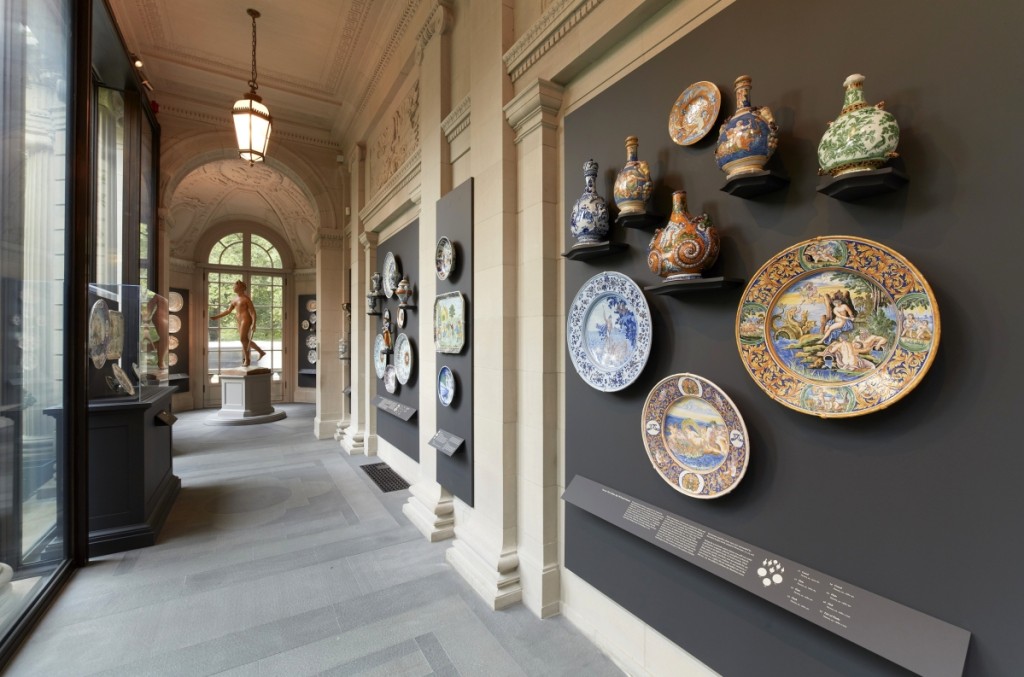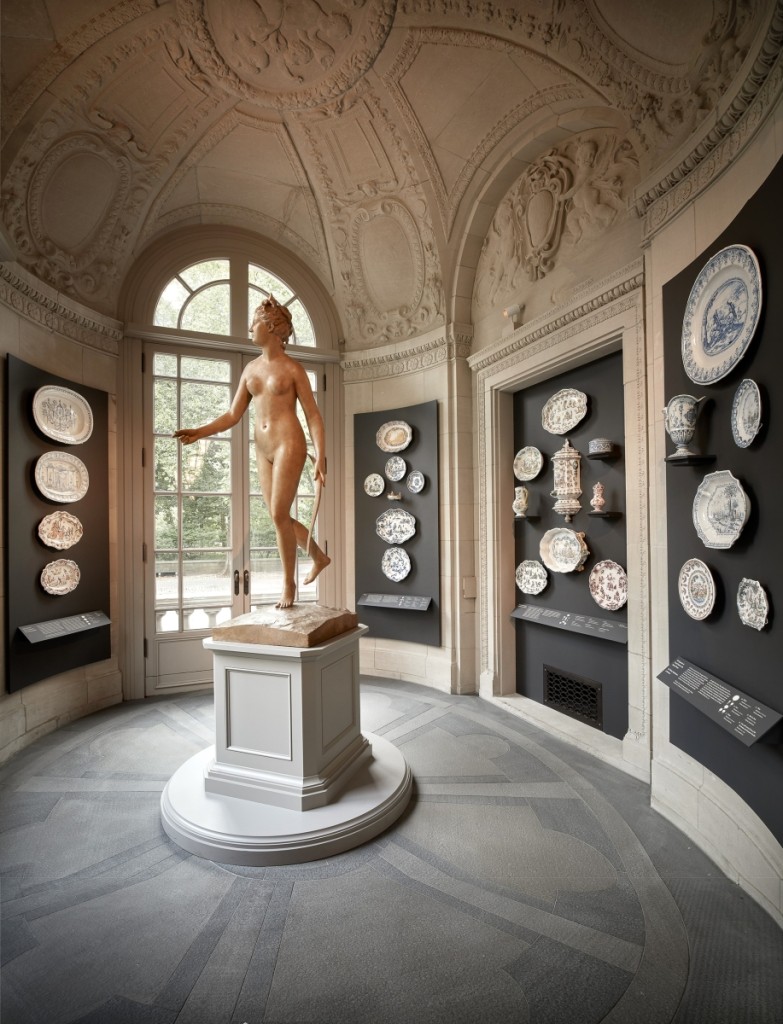
“Masterpieces of French Faience: Selections from the Sidney R. Knafel Collection” is on view in the Portico Gallery through September 22, 2019. A selection of pieces from Nevers is at right. They date from around 1670 to 1700.
By Laura Beach
NEW YORK CITY – Of all the arts, perhaps none has more visceral appeal than pottery. Its fundamental component – clay – is warm, tactile and quite literally earthy. Pottery making – mixing, kneading, shaping, glazing and firing – overtly parallels the most essential of human arts, cooking. Pottery is both sculptural and painterly. For design historians, its ubiquity and universality make it an apt marker of cultural change.
An exhibition at the Frick Collection through September 22 looks at French faience, a less familiar subgenre of the pottery field. The 75 pieces on view are drawn from the collection of Sidney R. Knafel, an American whose formative encounter with the material was via a Parisian flea-market find more than a half-century ago. Knafel has promised his faience to the Frick, whose reputation for European ceramics has grown exponentially in recent years. Between 2016 and 2018, the museum exhibited rare DuPaquier porcelain donated by Melinda and Paul Sullivan, and Meissen belonging to Henry H. Arnhold, who bequeathed the treasures to the Frick upon his death in 2018.
“Masterpieces of French Faience” was organized by the Frick’s curator of decorative arts, Charlotte Vignon, who brings special insight to her task. A Sorbonne-educated scholar of Eighteenth Century French decorative arts, Vignon was named a Chevalier of the Order of Arts and Letters by the French government in 2018. The French native has orchestrated related displays of Sèvres and Italian maiolica since taking up her post at the museum in 2009. Her 2016-17 show “Pierre Gouthière: Virtuoso Gilder at the French Court” was named the best decorative arts exhibition of the year by Apollo magazine.
Like Italian maiolica and Dutch delft, faience is a form of tin-glazed earthenware. The works on view were made in France from the late Sixteenth Century through the end of the Eighteenth Century. The earliest French faience, called grand feu, was ornamented with the limited number of oxides – cobalt (blue), antimony (yellow), manganese (purple-brown), iron (red-orange) and copper (green) – able to withstand high heat. By the mid-Eighteenth Century, market demand for a more varied palette led French potters to develop the petit feu technique, which entailed the reapplication of pigments before a second firing at a lower heat. Knafel’s passion is grand feu wares.
Tin-glazed earthenware originated in the Islamic world around 800 CE and by the Thirteenth Century had spread to Italy. Immigrant Italian potters and painters introduced the technique to Lyon, France, in the late Sixteenth Century. (As an aside, the French word faience derives from the name of the northern Italian city Faenza.) Faience making subsequently flourished in provincial centers from Rouen in the north to Marseille in the south.
The pieces on view were thrown on a potter’s wheel or formed in a mold. The early works from Lyon and Nevers were costly and intended for display only. Sumptuary laws passed by Louis XIV in 1679, 1689 and 1709 led to the smelting of precious metals and a corresponding increase in faience manufacture. As production costs declined, faience assumed more practical roles. Form followed function. Faience was fashioned into an array of vessels for containing toiletries, ink, snuff and medicines, among other items.
Manufacturing advanced from Lyon to Nevers, which for a time was the only faience-producing center in France and a rival to Delft, where tin-glazed earthenware production began around 1620. Then it was on to Rouen. The Provence workshops of Moustiers and Marseille emerged in the late Seventeenth Century, with workshops in Moulins, Montpellier and Sinceny following in the Eighteenth Century.
“I do not consider myself a specialist in French faience, but I love the medium because it is very rich,” Vignon told Antiques and The Arts Weekly. “Pottery is one of the oldest art forms and is made all over the world by so many different cultures, yet each time it takes a different form of expression. I love the secrets of the potters, passed down from one generation to the next, and carried from one place to another. Pottery is a pretty movable craft.”
Vignon serves up the world on a platter in her new show, which culls dishes, plates, platters, bowls, vases, boxes, brackets and figures from Knafel’s roughly 250 examples. Charming, varied and reflecting a fascinating array of global influences, the works are installed in the glass-enclosed Portico Gallery, overlooking the Frick gardens. The curator notes, “The Portico Gallery is a fantastic place to show ceramics because of its natural light. Ceramics are the rare medium that can withstand such light.”
Dating to about 1580, the oldest pieces on view are dishes, plates, platters and bowls made by Italian immigrant craftsmen in Lyon. With their classical subject matter and rich palettes of gold, blue, green and white, the objects strongly resemble the Italian maiolica that inspired them. Influenced by Urbino ceramics of a generation earlier, four pieces in the Knafel collection are thought to have been painted by Gironimo Tomasi.
Seventeenth Century pieces from Nevers are more varied in their influences, reflecting the different approaches of manufactories such as Les Trois Rois (The Three Kings), La Croix d’Or (The Golden Cross) and Les Trois Mores (The Three Moors), all headed by members of the Conrade family. Italian design dominance waned as the century wore on and craftsmen experimented with a dark ground known as “Nevers blue.” Shapes echoed silver from the French court, while decorative motifs ranging from the pastoral to the exotic derived from literature, print sources and imported luxury goods.
Rouen became a major production center in 1644 when Louis XIV granted Nicolas Poiret the exclusive right to produce faience in Normandy. Eighteen new manufactories opened after the royal privilege expired in 1698. Rouen faience of the first half of the Eighteenth Century is notable for its use of the lacy lambrequin pattern, which figured in borders or as overall decoration.
Much Eighteenth Century faience from the Provence towns of Moustiers and Marseille is reminiscent of toile, with patterns in a single color evenly scattered over a creamy ground. One arresting exception, a scalloped-rim platter of about 1730-40, is from Moustiers and was made by the Clérissy manufactory. Decorated in a palette of blue, gold and green, it is delicately painted with a scene of Asian merchants and soldiers enclosed in a foliate border.

The sun-splashed Portico Gallery is an ideal spot for showing ceramics, one of the few mediums that can withstand such light. Right is a selection of Eighteenth Century French faience from the manufacturing centers of Montpellier, Moustiers and Marseille.
Knafel writes that he never set out to be a collector. A repaired Rouen platter by chance shown to him by his late wife Susie piqued his desire to know more about French faience. There were few English-language references on the subject or notable public collections close to home to aid his quest. He reflects, “Museum exposure was limited in the United States to a restrained display at the Metropolitan Museum of Art, secreted in a dim lower-level gallery and seldom changed. French museums and dealers were an illusory balm, distanced by time and financial limitations.”
But with perseverance, Knafel succeeded. He writes, “…eventually more money and vacation time made travel and occasional acquisitions feasible. In sum, there was sufficient success to reward my efforts and patience, and to encourage my pursuit of knowledge and acquisitions. Consequently, I learned the challenges and delights of being a collector. This took nearly half of the 55 years that have passed since Susie handed that Rouen platter to me.”
Dealers – from “small town shopkeepers to major authorities in Paris” – were invaluable resources. Knafel singles out three merchants in particular: Christophe Perles, “a vital participant with a discriminating eye, consistently mentoring me to an ever higher standard of quality and beauty”; Louis Lefebvre, who “provided the unique, the unknown and many of the most exciting elements of my faience”; and the “young and scholarly” Camille Leprince, responsible for the “wondrous group of very early Lyon and Nevers treasures” that joined the Knafel collection in recent years.
When it came time to refine and present his holdings, Knafel’s second wife, ceramic artist Londa Weisman, was instrumental. Weisman, the collector explains, “adjusted the display, reinforced my judgment, and advocated still more purchases, even when wall space became scarce. She has introduced a most welcome new dimension.”
Knafel, Vignon says, “is a true intellectual and a fine connoisseur with a discriminating eye. He became interested in the earlier transitional pieces made in Lyon and in Nevers because they are the birth of French faience and were until recently not so well understood by collectors and scholars. The collection grew organically to completion.”
Vignon’s personal taste in French faience also runs to the early and rare. “Before 1720 are the ones I like best. After that, not so much,” she says. One of her favorite pieces is a spectacular ewer made in Nevers around 1680. More than 2 feet tall, it has elaborate handles simulating turned rope and is decorated in white on a blue ground with exotic, Orientalist figures. “It’s unique and a masterpiece,” she remarks.
Accompanying the exhibition is the catalog Masterpieces of French Faience: Selections from the Sidney R. Knafel Collection. Published by D. Giles, Ltd in association with the Frick Collection, it features essays by Vignon and Knafel, plus illustrations of all 75 works in the show.
This spring, the Frick will venture into the contemporary with a site-specific installation by ceramic artist and author Edmund de Waal. Organized by Vignon, the presentation pairing mostly porcelain sculpture with objects from the museum’s permanent collection opens May 30. Due out around the same time is Vignon’s new book Duveen Brothers and the Market for Decorative Arts, 1880-1940. Of her longstanding interest in social history, the art market and story of taste, the curator says, “It is something deeply rooted in my training at the Sorbonne. Collectors have been studied, but very little is known of the middlemen who created taste. The field has changed enormously in the last ten years, mostly because of research centers at the Frick and the Getty, and because of more classes on the art market are being taught at American universities. The subject is beginning to be a field in the United States.”
To purchase Masterpieces of French Faience: Selections from the Sidney R. Knafel Collection call 212-547-6848 or go to the museum’s online shop. The Frick Collection is at 1 East 70th Street. For more information, 212-288-0700 or www.frick.org.



















